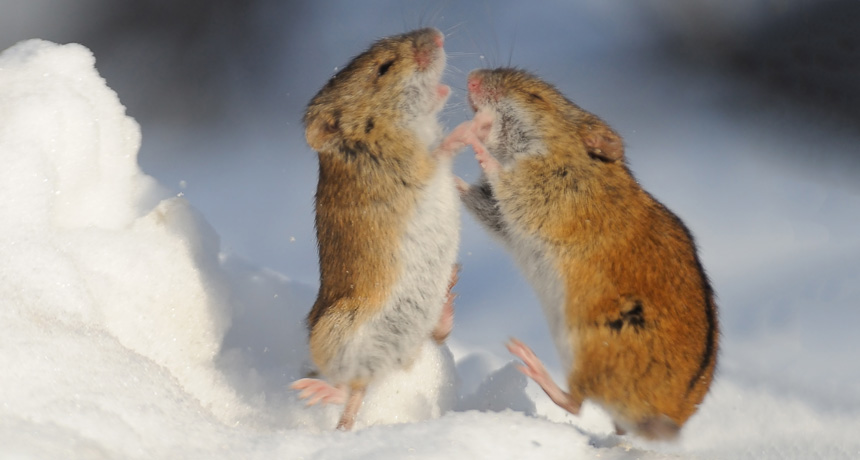Brain activity helps build an alpha male

Boosting the activity of certain brain cells can help a mouse climb the social ladder.
Nerve cells in a region called the dorsomedial prefrontal cortex appear to control whether male mice are dominant or submissive to other males, researchers report in the July 14 Science. The finding adds to previous evidence that this brain region is involved in social interactions in mammals.
Like men flexing muscles or flaunting sports cars to win status, male mice compete to establish a social pecking order. When every mouse knows his place, there can be less social conflict in the long run, says James Curley, a neurobiologist at the University of Texas at Austin who wasn’t part of the study.
In dominance tests, researchers pitted mice head-to-head in a plastic tube too narrow for the animals to pass each other. With no way forward, the lower-ranking mouse eventually retreats, pushed out of the tube by the more dominant mouse.
Researchers recorded the activity of individual nerve cells, or neurons, in mice’s brains while they engaged in the tube test. A group of neurons in the dorsomedial prefrontal cortex fired faster when mice were pushing forward to claim space in the tube, and fired more slowly as the mice retreated, says study coauthor Hailan Hu, a neuroscientist at Zhejiang University in Hangzhou, China.
Hu’s team then manipulated the activity of those neurons and once again measured the mice’s performance in the tube. Mice with these neurons inactivated via druglike small molecules didn’t try as hard on the tube task and were more likely to lose the competition, the researchers found. Mice with those neurons amped up with light, on the other hand, won against opponents who had previously beaten them. If those mice won enough times in one day, they’d even keep their newly elevated status for two or three days.
Other studies have also suggested a role for the prefrontal cortex in controlling social dynamics in several species, including humans, Curley says. The new study adds detail by allowing the researchers to track how neural firing influences behavior immediately and then follow the effect over time.
However, the tube experiment measures dominance dynamics in pairs of mice, Curley points out, rather than in larger groups. “Whether the same mechanism underlies social dominance under all contexts is yet to be discovered,” he says.
Other factors, such as an animal’s size, can also influence its ability to win a fight. But Hu says that persistence is key, and that this group of neurons appears to affect that quality. “In risk tests, what’s important is how much effort you want to put into the competition,” she says. “Some mice quit easily.”
Mouse studies like this one don’t translate directly to humans. But they allow scientists to study the neurobiology of dominance behaviors in levels of detail that aren’t possible in human subjects.
The study tested only male mice. In the future, Hu wants to find out whether a similar brain mechanism holds for female mice, too.